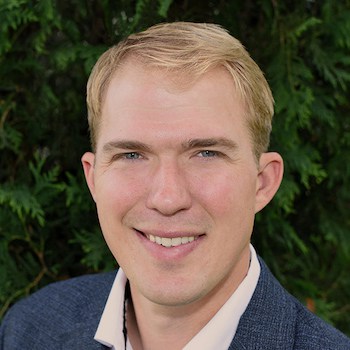Location
2966A Cooley
Phone
Website
Research Interests
Baalrud’s research concerns the theoretical foundations of plasma physics, with a focus on kinetic theory. It connects with several applications, including high energy density plasmas, low-temperature plasmas, and magnetic reconnection.
Strongly Coupled Plasmas
Plasmas are typically thought to be a gas-like state that is so hot that collisions between atoms cause electrons to separate from atomic nuclei. However, plasmas can also exist in more dense or cool conditions, where they behave more like ionized liquids, supercritical fluids, or even solids. These strongly coupled states of plasma behave in fundamentally different ways than their weakly coupled counterparts. Our work seeks to develop a theoretical understanding of the basic properties of strongly coupled plasmas. We use a combination of analytic techniques (math) and high-performance computer simulations. This work applies to a number of application areas, including high energy density plasmas used in inertial fusion energy research, high-intensity laser-plasma interaction experiments, plasmas at atmospheric and elevated pressures, ultracold plasmas, trapped antimatter plasmas, and dusty plasmas. It is also important in order to understand the physics of dense astrophysical objects, such as stellar interiors and white dwarf atmospheres.
Strongly Magnetized Plasmas
One of the most fundamental and beneficial properties of a plasma is that it can be controlled by magnetic fields. For example, this forms the basis for magnetic confinement concepts in fusion energy research. However, most plasmas are weakly magnetized in the sense that the gyromotion of particles induced by a magnetic field occurs at a scale that is much larger than the scale at which particles interact (the Debye length). Strongly magnetized plasmas correspond to the opposite limit. Our work seeks to develop a basic theoretical understanding of the properties of strongly magnetized plasmas, and to search for new physics that may be utilized in applications. We develop new approaches to kinetic theory, and use molecular dynamics simulations to test theory. This research is becoming increasingly relevant to experiments, as extremely high magnetic fields are becoming possible in high energy density plasmas, such as pinches, as well as in cold plasmas traps, including non-neutral plasmas.
Low-temperature Plasmas and Sheaths
Plasma modification of materials is at the heart of many of the most revolutionary technologies in our society. Current examples include efficient lighting sources, electric propulsion, and the manufacture of microelectronics. Upcoming examples include plasma-based medical technologies and technologies to improve the environment through waste remediation. Each of these rely on understanding how plasmas interact with their surroundings, which occurs through an electrostatic boundary layer called a sheath. Our work seeks to understand how sheaths work, and how they may be controlled in ways that are desirable for applications. We use analytic models, as well as particle-in-cell simulations in this work. It includes basic scientific studies, as well as applied projects in collaboration with experimental colleagues.
Plasmas & Nuclear Fusion
Education
University of Wisconsin-Madison
B.S. Nuclear Engineering and Mathematics (2006)
Ph.D. Engineering Physics (2010)
News
-
Five NERS faculty receive promotions
-
NERS astrophysics center hosts high-energy-density physics summer school
-
Exploring Cutting-Edge Research and Emerging Technologies in the World of Gaseous Electronics and Plasma Physics
-
Scott Baalrud receives funding to research high-energy-density plasmas
-
Scott Baalrud named to Physics of Plasmas Editorial Board
Honors and Awards
- American Physical Society Thomas H. Stix Award (2020)
- Hershkowitz Early Career Award (2018)
- University of Iowa’s Distinguished Mentor Award (2016) and Early Career Scholar of the Year Award (2017)
